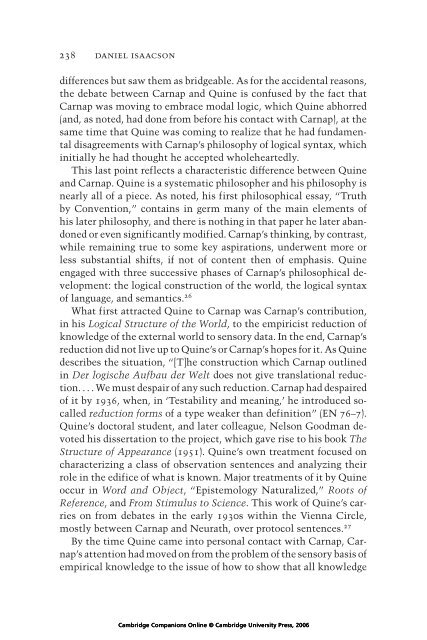Willard Van Orman Quine
Willard Van Orman Quine
Willard Van Orman Quine
You also want an ePaper? Increase the reach of your titles
YUMPU automatically turns print PDFs into web optimized ePapers that Google loves.
238 daniel isaacson<br />
differences but saw them as bridgeable. As for the accidental reasons,<br />
the debate between Carnap and <strong>Quine</strong> is confused by the fact that<br />
Carnap was moving to embrace modal logic, which <strong>Quine</strong> abhorred<br />
(and, as noted, had done from before his contact with Carnap), at the<br />
same time that <strong>Quine</strong> was coming to realize that he had fundamental<br />
disagreements with Carnap’s philosophy of logical syntax, which<br />
initially he had thought he accepted wholeheartedly.<br />
This last point reflects a characteristic difference between <strong>Quine</strong><br />
and Carnap. <strong>Quine</strong> is a systematic philosopher and his philosophy is<br />
nearly all of a piece. As noted, his first philosophical essay, “Truth<br />
by Convention,” contains in germ many of the main elements of<br />
his later philosophy, and there is nothing in that paper he later abandoned<br />
or even significantly modified. Carnap’s thinking, by contrast,<br />
while remaining true to some key aspirations, underwent more or<br />
less substantial shifts, if not of content then of emphasis. <strong>Quine</strong><br />
engaged with three successive phases of Carnap’s philosophical development:<br />
the logical construction of the world, the logical syntax<br />
of language, and semantics. 26<br />
What first attracted <strong>Quine</strong> to Carnap was Carnap’s contribution,<br />
in his Logical Structure of the World, to the empiricist reduction of<br />
knowledge of the external world to sensory data. In the end, Carnap’s<br />
reduction did not live up to <strong>Quine</strong>’s or Carnap’s hopes for it. As <strong>Quine</strong><br />
describes the situation, “[T]he construction which Carnap outlined<br />
in Der logische Aufbau der Welt does not give translational reduction....Wemust<br />
despair of any such reduction. Carnap had despaired<br />
of it by 1936, when, in ‘Testability and meaning,’ he introduced socalled<br />
reduction forms of a type weaker than definition” (EN 76–7).<br />
<strong>Quine</strong>’s doctoral student, and later colleague, Nelson Goodman devoted<br />
his dissertation to the project, which gave rise to his book The<br />
Structure of Appearance (1951). <strong>Quine</strong>’s own treatment focused on<br />
characterizing a class of observation sentences and analyzing their<br />
role in the edifice of what is known. Major treatments of it by <strong>Quine</strong><br />
occur in Word and Object, “Epistemology Naturalized,” Roots of<br />
Reference, and From Stimulus to Science. This work of <strong>Quine</strong>’s carries<br />
on from debates in the early 1930s within the Vienna Circle,<br />
mostly between Carnap and Neurath, over protocol sentences. 27<br />
By the time <strong>Quine</strong> came into personal contact with Carnap, Carnap’s<br />
attention had moved on from the problem of the sensory basis of<br />
empirical knowledge to the issue of how to show that all knowledge<br />
Cambridge Companions Online © Cambridge University Press, 2006
















